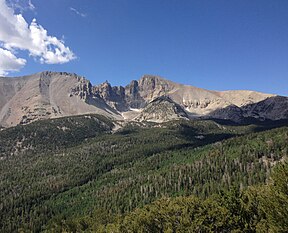Snake Range
| Snake Range | |
|---|---|
 Wheeler Peak, highest mountain in the Snake Range | |
| Highest point | |
| Peak | Wheeler Peak |
| Elevation | 13,063 ft (3,982 m) |
| Coordinates | 38°59′09″N 114°18′50″W / 38.98583°N 114.31389°W |
| Dimensions | |
| Length | 60 mi (97 km) North-South |
| Geography | |
| Country | United States |
| State | Nevada |
| Borders on | Schell Creek Range and Confusion Range |
This article needs additional citations for verification. (January 2024) |
The Snake Range is a
Geography
Typical of other ranges in the Basin and Range Province, the Snake Range runs in a north–south direction, for approximately 60 miles (97 km).
To the west are Spring Valley and the


Natural history
Several large groves of ancient Great Basin Bristlecone Pine (Pinus longaeva) trees thrive in the Great Basin montane forests of the range's higher elevations.
The higher elevations of the Snake Range in the northern section are protected by the Mount Moriah Wilderness Area, and in the southern section by the Highland Ridge Wilderness.


Peaks
Southern
The Snake Range includes two groups of peaks. The southern section rises quickly from a point near the border with Lincoln County, reaching the summit of Granite Peak (11,218 feet [3,419 m]) just 10 miles (16 km) to the north.
From there northwards the range continues to rise, passing
It finally reaches its apex at Wheeler Peak (13,063 feet [3,982 m]).
Northern
North of Wheeler Peak the range begins to drop, reaching 7,154 feet (2,181 m) at Sacramento Pass, just 11 miles (18 km) to the north. Sacramento Pass is where the more remote northern section of the range begins.
In just 12 miles (19 km) the North Snake Range rises past Silver Creek Canyon and Hendrys Creek Canyon to the summit of photogenic
North of "The Table" is another unusual geologic feature. Deadman Creek and Smith Creek, draining eastward into Snake Valley, combine to carve a deep canyon into the range. The mouth of this canyon lies below 3,000-foot (910 m) cliffs, 6,000 feet (1,800 m) below and 6 miles (9.7 km) away from the summit of Mt. Moriah.

The North Snake Range is an important geologic feature, containing some of the world's best examples of metamorphic rock and extensional deformation. The range has been designated as only the first 100 geoheritage sites by the International Union of Geological Sciences (IUGS).[5] Instead of normal faulting creating basins and ranges, like is seen throughout most of the Great Basin, the North Snake Range metamorphic core complex has undergone ductile deformation so that the metamorphic rocks have been stretched resulting in rocks that are 10% of their original thickness, stretching like taffy.[6]
References
- ^ U.S. Geological Survey Geographic Names Information System: Snake Range
- ^ "Wheeler Peak, Nevada". Peakbagger.com.
- ^ "Nevada 11,000-foot Peaks". Peakbagger.com. Retrieved 2014-10-22.
- ^ "Doso Doyabi". Geographic Names Information System. United States Geological Survey, United States Department of the Interior.
- ^ "Northern Snake Range metamorphic core complex". IUGS. Retrieved 2024-03-27.
- ISBN 978-0-8137-9555-3.

